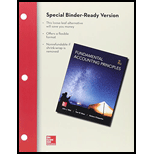
Internal Control: Internal control is a process of minimizing any operational error and financial reporting error and achieving organizations objectives.
The principles of internal control.
Answer to Problem 1DQ
Solution
Following are the seven principles of internal control:
1) Establishing responsibility.
2) Maintaining adequate records.
3) Insuring asset and bond key employees.
4) Separating record keeping from custody of assets.
5) Dividing accountability for related transaction.
6) Applying technological controls.
7) Performing independent and regular reviews.
Explanation of Solution
For internal control, there should be established responsibility for specific transaction so that if anything goes wrong then organization can held someone responsible or faulty. The second principle tells us to maintain adequate records of all transactions. As per the third principle, a firm needs to insure its assets against any casualty. As per the fourth principle, there should be different persons one who is controlling the asset and another who is keeping the accounting record of an asset. As per the fifth principle, there should be a division of responsibilities related to one transaction among two three employees so that an automatic check on each persons can be maintained. As per sixth principle, by adapting the technologies, we can improve the level of internal control. In last we need to perform regular reviews to make sure that everything is in aligned with the goals of the organization.
The principle of internal control helps in monitoring and verifying business activities.
Want to see more full solutions like this?
Chapter 8 Solutions
Loose Leaf for Fundamentals of Accounting Principles and Connect Access Card
- I am trying to find the accurate solution to this general accounting problem with appropriate explanations.arrow_forwardI am searching for the accurate solution to this general accounting problem with the right approach.arrow_forwardCan you explain the correct approach to solve this general accounting question?arrow_forward

 AccountingAccountingISBN:9781337272094Author:WARREN, Carl S., Reeve, James M., Duchac, Jonathan E.Publisher:Cengage Learning,
AccountingAccountingISBN:9781337272094Author:WARREN, Carl S., Reeve, James M., Duchac, Jonathan E.Publisher:Cengage Learning, Accounting Information SystemsAccountingISBN:9781337619202Author:Hall, James A.Publisher:Cengage Learning,
Accounting Information SystemsAccountingISBN:9781337619202Author:Hall, James A.Publisher:Cengage Learning, Horngren's Cost Accounting: A Managerial Emphasis...AccountingISBN:9780134475585Author:Srikant M. Datar, Madhav V. RajanPublisher:PEARSON
Horngren's Cost Accounting: A Managerial Emphasis...AccountingISBN:9780134475585Author:Srikant M. Datar, Madhav V. RajanPublisher:PEARSON Intermediate AccountingAccountingISBN:9781259722660Author:J. David Spiceland, Mark W. Nelson, Wayne M ThomasPublisher:McGraw-Hill Education
Intermediate AccountingAccountingISBN:9781259722660Author:J. David Spiceland, Mark W. Nelson, Wayne M ThomasPublisher:McGraw-Hill Education Financial and Managerial AccountingAccountingISBN:9781259726705Author:John J Wild, Ken W. Shaw, Barbara Chiappetta Fundamental Accounting PrinciplesPublisher:McGraw-Hill Education
Financial and Managerial AccountingAccountingISBN:9781259726705Author:John J Wild, Ken W. Shaw, Barbara Chiappetta Fundamental Accounting PrinciplesPublisher:McGraw-Hill Education





